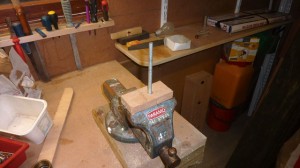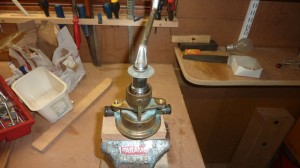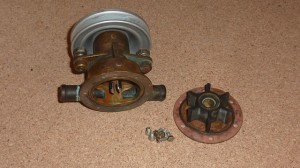Peter Lyle refurbishes the seawater pump on his Jeanneau 36i for a fraction of the cost of replacement or professional repair
Before leaving our anchorage in Loch Claidh on the Isle of Lewis aboard our Jeanneau 36i Albatross, I had a quick look at the engine. I noticed that there was a fine rusty line in an arc around the engine compartment: it seemed to radiate from the seawater pump. Without the wherewithal to investigate it properly, we decided to set off for Loch Harport on Skye anyway.
The wind soon died and we motored for the last six hours of the voyage. Having anchored, I checked the engine again. There was rust and water all over the engine bay. Even with the engine stopped there was a generous trickle of seawater from the back of the pump. A few more hours and we would be sinking. Fortunately, we had a spare pump and these are easy to fit. As
I removed the old pump, half a dozen ground-up ball bearings fell out. The pump had been within minutes of complete failure.
Returning home at the end of the season, I looked up the prices for repair or replacement of the pump. A Yanmar 3YM30 seawater pump retails at about £280: alternatively, buying all the spares I needed from a marine supplier, even if I could source them, looked to be very expensive. I found a ‘cheap’ repairer on eBay. His estimate climbed to over £150. I thought about fixing it myself but had none of the specialist tools needed for pressing the bearings into place.
New bearings
Taking the pump apart was easy. I removed the faceplate and the impeller plus a circlip that held the back bearing in place. The pump then simply fell apart in my hands: a pile of rust, some ball bearings, two broken bearings, a water seal and the main spindle complete with the one remaining circlip.
Every sailor needs a Vernier caliper (about £13 from Screwfix). Armed with sizes of all the broken parts, a local engineering supplier provided me with both the bearings, the circlips and the shaft seal (plus a spare) for £20 all in. The shaft itself was undamaged: this was fortunate as spares retail at over £80.
I cleaned up the old pump body with a toothbrush, cleaned the rusty pulley wheel with emery cloth and gave it three coats of paint. I found an exploded diagram of a similar pump on the internet and started putting things back together again.
I pressed in the inner bearing by forcing it down on a piece of threaded studding held in a vice. The studding sticks upwards from the vice, through a small piece of wood (to protect the water
pump body), through the pump, on through the bearing and thence through two wrench sockets and a large washer. Tightening the nut on the top of this arrangement pushes the bearing into place.
Next, the central shaft slipped in easily, complete with one of the circlips and a spacer. I drove the other bearing into place with a spark plug spanner which I tapped gently with a small hammer. A circlip holds the bearing in place.
A rubber O-ring sits between the water seal and the inner bearing to help prevent seawater from reaching the bearing. The water seal is easy to push into place: the impeller, gasket and front plate are all easy as well.
Hey presto, one refurbished water pump. Parts cost £20, the Vernier caliper was £13, and the circlip pliers £10.








